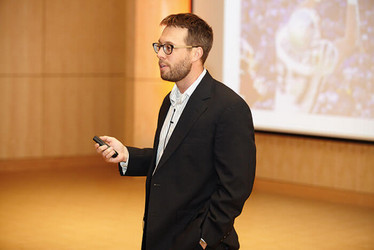Gene Genie
Sitting Down With…John Doench, Associate Director, Genetic Perturbation Platform, Broad Institute, Cambridge, MA, USA.

Did you always want to be a scientist?
When I was eight years old, I wanted to own a stationary supply store. At college, I took a lot of science classes but majored in history. After I graduated, I knew I liked science but I still didn’t know what I wanted to be when I grew up. Initially, applying for a PhD was an appealing way of avoiding any further life decisions. Things didn’t really click for me until I visited MIT for their PhD interview weekend. Immediately, I knew that this is what I wanted to do. During the interview weekend, I went to a short talk by Phil Sharp about the then-recent discovery of RNAi and I was gripped. I joined the Sharp lab for my PhD and spent the next five years learning about RNAi.
What was it about RNAi that had you hooked?
What first excited me about RNAi was how much we didn’t know – it was a black box. If you had read four papers on RNAi, you had read the complete literature. It was clear that if you introduced double-stranded RNA into cells it eventually led to gene silencing, but we had no idea how. My PhD work focused on understanding the mechanism of microRNAs and how they find and regulate their targets. Once we understood the mechanism, it quickly became clear to me that RNAi was a potentially very powerful tool for understanding gene function – functional genomics – and that has been the focus of my work ever since. When CRISPR/Cas9 came out – another gene-editing technique involving small RNA– it was a no-brainer to incorporate that into our work too.
So it’s an exciting time for functional genomics...
Absolutely – because we have so many tools. Fifteen years ago the only way to do genetics in mammalian cells was to make mouse knockouts, which is a really slow process. You couldn't do gene editing or functional genomics in human cells. But first with RNAi, and now with CRISPR, you can manipulate the cell in so many ways to understand gene function.
Will CRISPR replace RNAi?
I don’t think so. I do think that CRISPR should be the first item in your toolkit for a new model because it does seem to be more robust. But all methods of gene editing have flaws, and if you are really invested in a particular cellular model (for example, in therapeutic discovery) and put a lot of care into building that model, then it makes sense to screen it with all potential modalities to get a complete picture. RNAi is not yet dead!
Is CRISPR/Cas9 as simple to use as it seems?
Anyone can get going with CRISPR – it’s a very democratic tool. But there’s a big difference between someone wanting to knock out a single gene of interest versus doing large-scale genome-wide screens. Doing CRISPR screens is conceptually straightforward, but there are a lot of ways to do it wrong. I worry about that, especially in terms of what data is being contributed; once a screen has been done, no one is going to do that screen again any time soon, so it’s critical to get it right first time.
How do you help people get it right?
Broad Institute operates a platform model, with groups of scientists that focus on a particular technology – in my case functional genomics. You can essentially apply functional genomics to any biological problem, so we work across many different models. In a single day, I might have meetings on diabetes, infectious diseases, and cancer. We help our collaborators use functional genomics to move their research forward, and in turn they help us develop and optimize our tools. By partnering with a lot of biologists in different fields, we get to know the critical challenges across different models. It’s hard to develop technology in a vacuum... Unless you know what nails you need to hit, you can’t know what type of hammer to make.
What projects are you particularly excited about?
On the technology side, I’m very interested in ways to increase the titer of the lentiviral vector to make the system easier to use. We’re also trying out new versions of Cas9, and testing them against each other. I want to rigorously compare them with large datasets, and determine where the strengths and weaknesses of each lie, rather than using one by default.
On the biology side, I'm working with infectious disease biologists to categorize the critical host factors for a whole variety of bugs. We’re answering questions about exactly how pathogens evade the immune system and cause disease, which is opening up exciting new avenues of translational research. Likewise, in cancer biology, we're pinpointing the vulnerabilities of cancer cell lines – their Achilles’ heel.
What’s next for your lab?
One thing I’m particularly interested in is figuring out how gene interactions work. Right now, we’re knocking out one gene at a time, and that may tell us what that one gene does. But there are going to be a lot of phenotypes that emerge only when you knock out two or more genes at a time. There are around 20,000 protein-coding genes in the human genome, which gives us 400 million possible combinations – that is some very big data. And a very interesting problem.
Associate Director, Genetic Perturbation Platform, Broad Institute, Cambridge, MA, USA.















